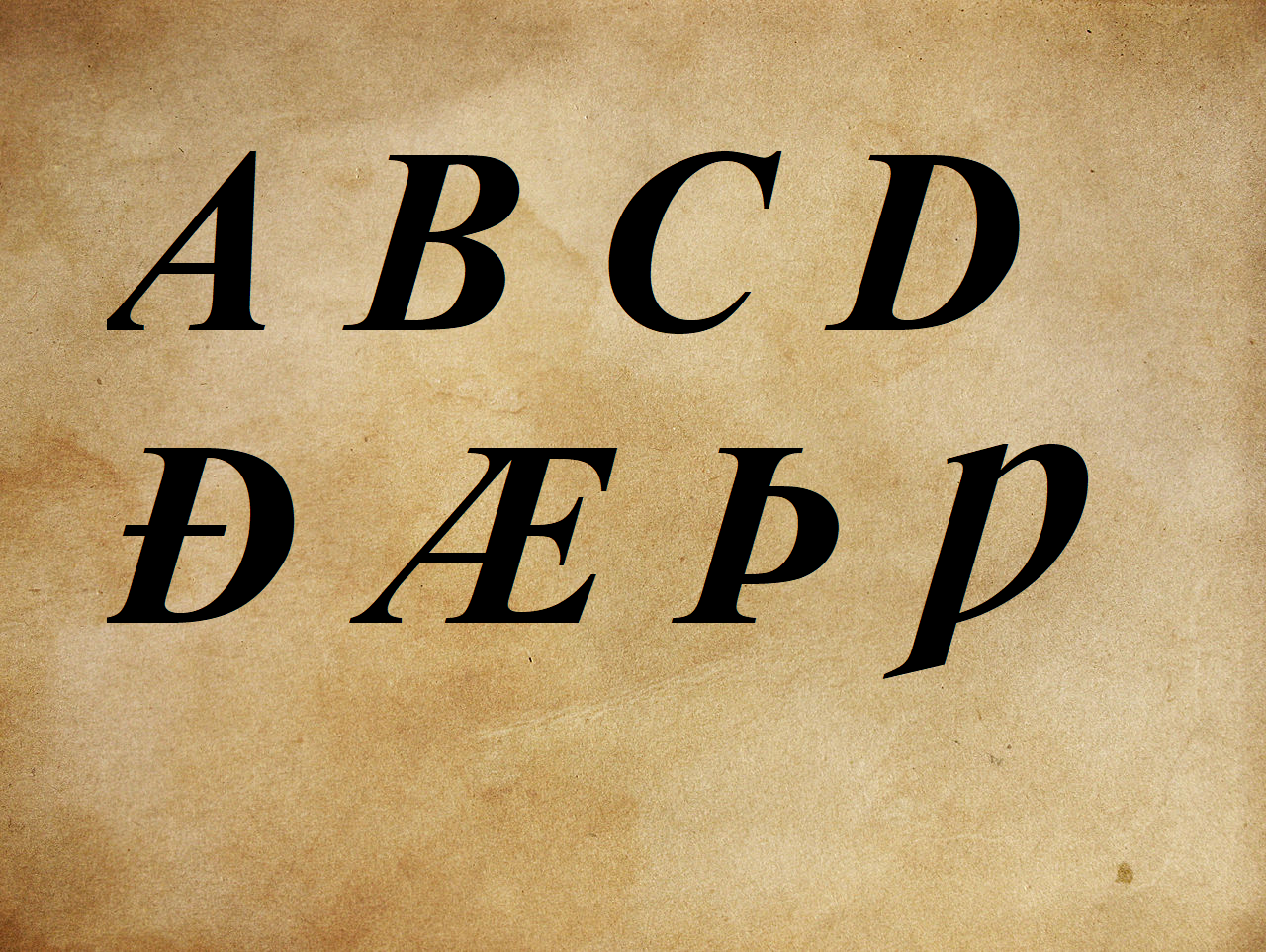Ye Olde Thorn

It’s been a long journey for the English language. Originally not a language at all, but a budding dialect waiting to bloom from the rough-hewn stem of Old Germanic (itself a child of Indo-European, grandchild of Proto-Indo-European, and great-great-grandchild of tree-screeching), li’l English was born far away from the robust headache it strove to become.
Left alone on the cloudy isle of Great Britain with no one to play with (the Celts just changed their “maybe” to a firm “no”), the Anglo-Saxons embarked on the slow, slow journey of becoming more Anglo and less Saxon. Their biggest change, though, came after a visit from France. Maybe less a visit, more an advanced episode of squatting. The guy in question, William the Conqueror, had conquered them. Nominative determinism is crazy.
At William’s back was his posse of Normans, who hail from Normandy, right across the English Channel. In a grand display of respect to the Normies (and disrespect to the Anglest of Saxons), William immediately appointed all of his buds to elite positions in his newly-conquered country. Given that these new bigwigs had all come from France, they all spoke French, or at least something resembling it. As a result, the monarchy became associated with the language, and fancy French vocabulary would become integrated into English as it drifted downward to the peasantry.
French wasn’t alone, of course; the English language would come to test its linguistic strength against the hard nouns and verbs of Latin, the continental lingua franca of its day. By the time William wrecked Harold II’s shit at the Battle of Hastings, Roman influence in Britain had existed for a thousand years. England had, itself, once been part of the Roman Empire, which established the city of Londinium, a city we know today as Birmingham (read: London). The Romans, uninterested in kilts, haggis, and freedom, would also build a wall along the Scottish border. That wall, Hadrian’s, would later influence the wall of Game of Thrones fame, but guess which one was taller? …the Game of Thrones one, obviously. Hadrian’s wall suffered from the architectural flaws of being made out of stone rather than enchanted ice and being prone to jumping.
Latin would also retain its relevance in the British realm due to the influence of the Catholic Church, which was a religion popular at the time.
After the fall of Rome and the rise of the Anglo-Saxon settlers, Latin would fall pretty sharply in favor of the barbarous rumblings of Germanic tongues. Just as Latin developed its own fanciful script to write with, these rough-hewn dialects would come to have their own, which they either stole from the Dutch or stole from the continental non-Dutch peoples of Europe, allowing the Dutch to steal it from them. “Dutch” here meaning “Frisians”, the people north of the Southern Sea, but that’s not really important to our story.

Unlike the Romans, who wrote with letters, the Anglo-Saxons used a system of runes, which are letters for poor people. The Anglo-Saxon runic alphabet had somewhere between 24 and 26 letters runes in it, depending on when you’re asking (1600 years ago would be ideal). This runic alphabet would work great for the people of pre-Norman England and Britain until the 7th or 8th century when our yet-unseen friends the Catholic Church showed up and decided these angled inscriptions were decidedly un-Jesuslike. More realistically, they were not Latin, which stood against the Catholic linguistic policy of being Latin.
Over the next few hundred years, the Christianization of Britain would lead to the adoption of the Old English Alphabet, a knock-off clone of the Latin alphabet with a few accommodations. Of these accommodations, two were tricked-out versions of Latin letters specialized for English, and two were secret runes that had managed to slip in from that runic alphabet I just told you about.
Let’s start with the personalized Latin letters. The first is one that persists today, albeit in a weakened form that begs to be taken out back and put out of its misery. Who is it? It’s aesc, of course! Or ash. You’ve seen it as “æ”, which you probably call by the letters “a” and “e”, and which itself is absolutely unreasonable. There’s no space between them, and that makes them one letter: ash. Ash developed as a letter used to replace the rune ash, which made approximately the same sound. That sound? I don’t know, “long E” I guess? Think encyclopædia or pædiatric.
The second letter made over from Latin was “eth”, written “Д or “ð”, depending on whether or not the Anglo-Saxons were holding down the shift key. This letter represented the “th” sound we know and love, sorta. The Anglo-Saxons loved their “th” sound enough to denote it a little more specifically. Eth originally made the “hard” th heard in “the” and “this”. Where did it come from? I don’t know. These are the (historically disavowed) Dark Ages. We’re lucky we got this far. Regardless, some sources suggest eth made the leap from Irish. I can’t prove that, though, so take it with a grain of ðalt. Today, eth actually still exists as part of the Icelandic alphabet and fulfills a similar role. Kinda neat.
Our next couple of letters aren’t letters at all, but runes in disguise. You can feel the lack of refinery. The first of these is Wynn, written “ƿ”. This one, true to its name, made a sound we now associate with the letter W. From the start, Wynn had a raw deal as part of the English language, and it never quite got the love it deserved. Almost immediately, it found itself part of a feud against the formidable foe that is “two Us”. Eventually, our friend Wynn would find itself unable to compete against the newly-minted “Double U”, which combined all the best things about two Us into a single letter. Today, I’m not so sure we made the right choice. W looks fine, I’ll give it that; Wynn looks more like a heavy-set P than its own letter. Still, “Double U” is such a stupid name for a letter. Have you ever noticed that every other letter is one syllable long and mostly imitates the general sound it makes (Americans can pour one out for “h”)? Meanwhile, W is a three-syllable phrase that only technically seems to capture its intended sound. The verdict? We’re calling W “Wynn” now. Tell your friends.

The second of these runic stowaways is Thorn. You might know it from the title of this article. Written Þ or þ depending on how recently the Caps Lock key has been pressed, Thorn was the other half of the “th” split, representing the softer side of the sound, the lovable phoneme found in “thought”, “thrush”, or, I guess, “thorn”. Like its cousin eth, Thorn’s legacy continues today in the Icelandic alphabet, kept alive by the residents of a barely-populated (and beautiful) island of (very lovely) frost people. Further south, though, thorn met a grimmer fate.
As everything language-adjacent seems to do, thorn changed over time, and eventually its handwritten form came to look mighty similar to the letter “Y”, which at the time looked mighty similar to the letter “Thorn”. Following the advent of printing in Europe, English writers and typesetters started importing printing presses from across the channel in Germany and France. Not properly indoctrinated in the virtues of thorn, these presses didn’t include keys for it, making it impossible to include in type. They did, however, have “Y” which, again, looked similar enough, so they used it instead.
Eventually, in this way, “thorn” was phased out, and eventually, the combination of “t” and “h” would come to replace both sounds. Before this ultimate death of eth and thorn, though, they would make a move to secretly cement their legacy in the English language. The reign of “Y” in place of thorn was relatively short-lived, but it made its mark in the phrase “the old”, oft-written, in turn, as “ye olde”. Today, our idiot brains pronounce the “y” the only way we know how, the way we’ve been taught to read English’s lonely sometimes vowel. We’ve been naïve not to unmask it and know it as the continuation of thorn, English’s last remaining rune, holding on by ye slightest margin of a yread.
I spent this whole piece talking about the four unique letters of the English language, but in doing so, I lied. Sort of. Depending again on who you ask, there are a few more. This Mentalfloss article lists twelve of them, from the æ-adjæcent œ to the ampersand (&) which was once ubiquitous enough to be considered a letter in its own right. To describe all of them here would be less informative than plagiaristic, so I’ll point you that way instead.
Similarly, I wrote at length about the influence of French, Latin, and Old Old Germanic on the English language, but to stop there is a tiny bit unrealistic. For one, I’ve ignored the couple hundred years that England (and other bits of Great Britain) were under Danish viking influence (now known as the Danelaw), which is a pretty insane thing to ignore. Beyond direct rule, though, English, as most languages, isn’t a walled-off bastion. Throughout its millennia of development, it’s been influenced by Frisian, Dutch, Italian, Greek, Arabic, Hindi, Mandarin, and just about every other linguistic dominion English speakers have interacted with. That’s a lot more paragraphs, though, and far too many just to explain one letter we don’t even use anymore.
Ðat’s all for noƿ.
(Old English enthusiast or stroke victim? You decide.)
Read More
- 12 Letters That Didn’t Make the Alphabet by M Asher Cantrell for MentalFloss
- The Norman Conquest by from the BBC
- Eth, thorn, and ash: they flunked the screen test for our alphabet by Cynthia Haven for Stanford University’s The Book Haven
- We used to have six more letters in the English alphabet by Hannah Poindexter for Quartz